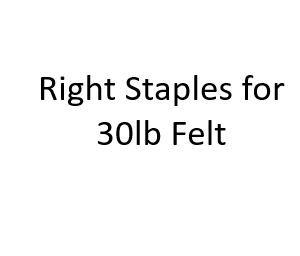When it comes to roofing and construction projects, selecting the right materials and accessories is crucial for ensuring durability and longevity. One often-overlooked aspect is the choice of staples for securing roofing felt. In this blog post, we will delve into the world of roofing felt staples and specifically discuss right size staples are ideal for 30lb felt.
Understanding Roofing Felt
Roofing felt, also known as tar paper or roofing underlayment, is a vital component in roofing systems. It serves as a protective barrier between the roof deck and the shingles or other roofing materials. Roofing felt is available in various weights, with 30lb felt being a popular choice due to its durability and weather resistance.
The Importance of Proper Staples
Staples play a pivotal role in securing roofing felt to the roof deck. They ensure that the underlayment remains in place during installation and throughout the life of the roof. Using the wrong size staples can lead to problems such as tears in the felt, reduced water resistance, and compromised structural integrity.
Choosing the Right Staple Size
- Length Matters: When selecting staples for 30lb felt, it’s essential to consider the length. The staples should be long enough to penetrate through the felt and securely into the roof deck. Typically, staples ranging from 3/8 inch to 1/2 inch in length are suitable for this purpose.
- Gauge or Thickness: The gauge of the staple wire also affects its performance. For roofing felt, staples with a 16 or 18-gauge thickness are commonly used. These gauges strike a balance between strength and flexibility, ensuring that the staples can withstand the rigors of installation without causing damage to the felt.
- Crown Width: The crown width refers to the top part of the staple that comes into contact with the roofing felt. Staples with a narrow crown are often preferred for roofing felt as they create less stress on the material. A crown width of 3/8 inch is a suitable choice for 30lb felt.
- Material Composition: Staples can be made of various materials, including galvanized steel and stainless steel. Galvanized steel staples are cost-effective and provide good corrosion resistance. However, if you’re in an area with high humidity or salt exposure, stainless steel staples may be a better option due to their superior corrosion resistance.
Installation Tips
Now that you’ve chosen the right size staples for your 30lb felt, here are some installation tips to ensure a secure and long-lasting roofing underlayment:
Proper Spacing: Ensure that you space the staples evenly along the edges and seams of the roofing felt, following the manufacturer’s guidelines. This helps prevent wind uplift and water infiltration.
Avoid Overdriving: Be cautious not to overdrive the staples, as this can damage the felt or roof deck. Use a staple gun with adjustable settings to control the depth of penetration.
Inspect for Tears: After securing the roofing felt with staples, inspect the surface for any tears or gaps. Repair any damage before proceeding with the installation of shingles or other roofing materials.
In addition to the essential considerations mentioned above, there are a few more tips and insights to keep in mind when working with roofing felt and staples:
Overlap Seams: When installing 30lb felt, it’s crucial to overlap the seams properly. Overlapping helps create a continuous barrier that prevents water infiltration. Generally, a minimum overlap of 4 to 6 inches is recommended for most roofing felt products.
Weather Considerations: Pay attention to the weather conditions during your roofing project. If it’s particularly hot outside, the roofing felt may become more pliable, making it easier to work with. Conversely, in colder conditions, the felt may be stiffer and require more care during installation to avoid tears.
Staple Placement: While most of the staples will be used along the edges and seams of the roofing felt, you should also consider the field or central area. Some installers prefer to add additional staples in the field, especially in windy areas, to provide extra security.
Safety First: Roofing work can be hazardous, so always prioritize safety. Use proper safety equipment such as harnesses, gloves, and safety glasses. Make sure the roof deck is structurally sound before starting any work.
Consult Manufacturer Guidelines: Manufacturers often provide specific guidelines for the installation of their roofing felt products. It’s crucial to consult these guidelines and follow them closely to ensure the best performance and warranty coverage.
Regular Inspection: After the roofing underlayment is installed and before adding the final roofing material (shingles, tiles, etc.), take the time to inspect the entire surface. Look for any visible tears, ripples, or gaps in the felt. Address any issues promptly to prevent future problems.
Consider a Professional: If you’re not experienced with roofing installations or have doubts about your abilities, it’s wise to hire a professional roofing contractor. They have the expertise and tools necessary to ensure a proper installation.
Conclusion
In conclusion, selecting the right staples for 30lb roofing felt and installing them correctly is a crucial step in the roofing process. By carefully choosing the staple size, spacing them appropriately, and following best practices during installation, you can protect your investment and ensure the longevity of your roof.
Remember that roofing work requires attention to detail and safety precautions. If you’re uncertain about any aspect of the project, seeking professional assistance is a wise decision. With the right staples and proper installation techniques, your roofing underlayment will provide the necessary protection for your home or building for years to come.
